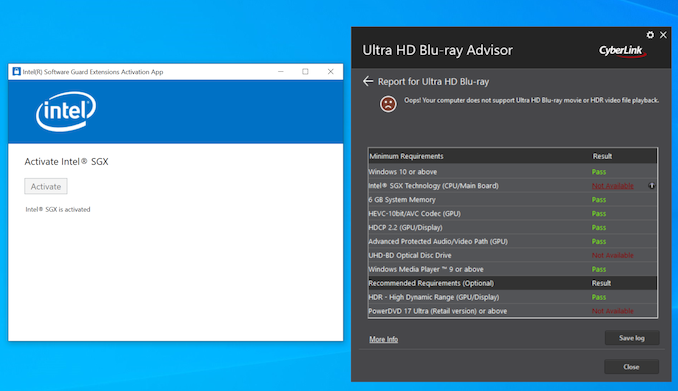Intel NUC10i7FNH Frost Canyon Review: Hexa-Core NUC Delivers a Mixed Bag
by Ganesh T S on March 2, 2020 9:00 AM ESTHTPC Credentials - Display Outputs Capabilities
The
Supporting the display of high-resolution protected video content is a requirement for even a casual HTPC user. In addition, HTPC enthusiasts also want their systems to support refresh rates that either match or be an integral multiple of the frame rate of the video being displayed. Most displays / AVRs are able to transmit the supported refresh rates to the PC using the EDID metadata. In some cases, the desired refresh rate might be missing in the list of supported modes, and custom resolutions may need to be added.
Custom Resolutions
Our evaluation of the
The gallery below presents screenshots from the other refresh rates that were tested. The system has no trouble maintaining a fairly accurate refresh rate throughout the duration of the video playback.
High Dynamic Range (HDR) Support
The ability of the system to support HDR output is brought out in the first line of the madVR OSD in the above pictures. The display / desktop was configured to be in HDR mode prior to the gathering of the above screenshots.
The CyberLink Ultra HD Blu-ray Advisor tool confirms that our setup (
[Update (3/17/2020): While I continue to have terrible luck in enabling SGX to operate correctly with the CuberLink Ultra HD Blu-ray Advisor tool, Intel sent across proof that the Frost Canyon NUC is indeed capable of playing back Ultra HD Blu-rays.
It is likely that most consumers using the pre-installed Windows 10 Home x64 / pre-installed drivers will have a painless experience unlike mine which started off the system as a barebones version.]




















85 Comments
View All Comments
TheinsanegamerN - Monday, March 2, 2020 - link
Bleh UHD graphics. Terrible. The previous NUCs had Iris plus GPUs. AMD APU NUCs would dominate these things.drexnx - Monday, March 2, 2020 - link
looks like the 2 year old 2400G already does, a 4800U would embarrass thistimecop1818 - Monday, March 2, 2020 - link
Yeh, if only AMD had stable/working graphics. Oh, wait...kaidenshi - Tuesday, March 3, 2020 - link
If only you had something else to troll about. How about some citations to back up your claims? Going on a year with my 2400G APU based system with zero graphics issues and far outperforming any Intel iGPU. There's a reason Intel chose AMD graphics for its Hades Canyon NUC.MenhirMike - Wednesday, March 4, 2020 - link
I think he might mean the (very real) issues that the RX 5x00 drivers have, like stuttering and random driver crashes. This has been much improved in later drivers, my 5700 XT is running perfectly fine now, but there were definitive issues. That said, those are Navi cards while integrated GPUs (which are applicable here) are using Vega. And initially, there was an issue with at least mobile APUs where AMD didn't offer their own drivers - I got a Ryzen 5 2500U laptop, and for the first year, I had to deal with way outdated drivers from Dell. But AMD finally came around and is now offering first-party drivers.So: There were definitive issues, there might still be issues, but it seems that all the big ones are resolved.
HStewart - Monday, March 2, 2020 - link
You got to take in account of the market of this machine, most people do not need high end graphics for games and such. This is also likely use for engineering stuff where graphics is not actually used too much - like a monitor system, or back office systems for services and possibly reports.29a - Monday, March 2, 2020 - link
That's still no excuse for Intel's horrible iGPUs.Qasar - Monday, March 2, 2020 - link
nope.. but hstewart, will keep making excuses for them. sorry hstewart, amds new apus would be for this market, and would probably out perform this by quite a bit. face it, your beloved intel, has lost this round.The_Assimilator - Monday, March 2, 2020 - link
I strongly doubt that even AMD's latest APUs can idle with a 4K display at under 5W. That power-sipping performance is critical to the market segment these devices are aimed at.evernessince - Tuesday, March 3, 2020 - link
Well yes if you are comparing desktop APUs vs the mobile chip in this system. If you compare apples to apples though, AMD certainly does have chips capable of idling that low even on the high end: https://www.notebookcheck.net/Lenovo-ThinkPad-T495...And that's with last generation Zen+, not Zen 2.